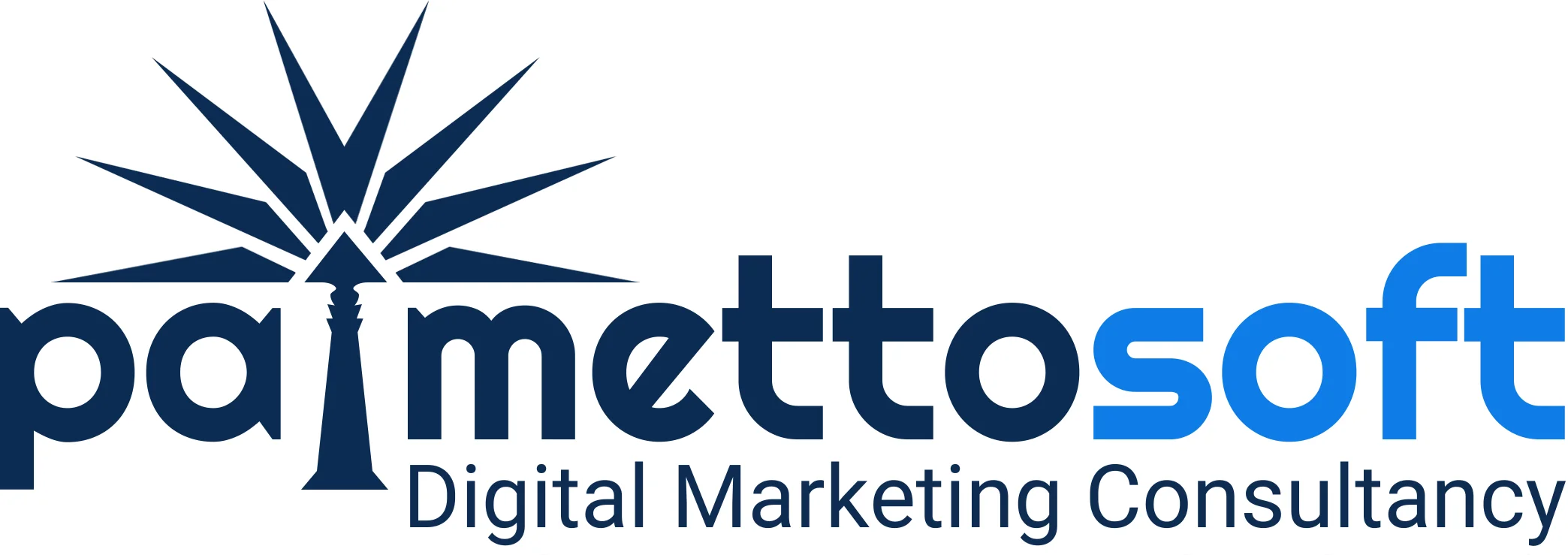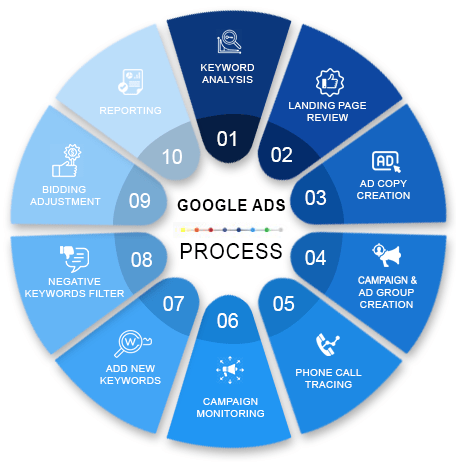Introduction
The purpose of this article is to explain our in house Google Ads Process for a basic campaign. As you may know, a Google Ads Process can be also known as a Google Ads Strategy and two terms are commonly used interchangeably and we also do the same in this post.
Google Ads is a form of Pay Per Click (PPC) advertising, where advertisers pay the search engine directly for clicks from potential customers.
For reference, the most popular advertisers for PPC are Google, Amazon, Facebook, Bing and Yahoo. And unlike the organic/SEO search results, where Google currently holds 93% of all searches, the PPC market is more fragmented with the top three being Google, Amazon and Facebook.
With the onset of COVID 19 in early 2020, Amazon experienced a meteoric rise mainly due to online shopping and its strategic ability to respond to that demand. For the sake of staying on topic and brevity, we are only going to focus on Google Ads in this article.

You NEVER want to approach blogging with the mindset that “it’s a task I have to do.”
If you do, you will quickly become part of the status quo of the millions of average bloggers that waste time and effort on the Internet.
Instead, you should look forward to writing about things that you are passionate about or may be an expert in. Your readers and search engines like engaging and informative content, so always do your best!
These same habits will carry over into all aspects of copywriting you do on your website.
Also know this: It is good to have a strong opinion. Try not to be vanilla and boring. On the flip side, don’t use profanity, disrespectful language, or claims that are so over-the-top that you make some people angry or offend them.
Let me prove the math on the above: You have already invested some of your valuable time reading this post. If it was bad content, you probably would have left a long time ago!
What is a Google Ads Process?

According to Merriam-Webster, a process is a series of actions or operations conducing (causing) to an end.
And our layman’s explanation of the term “process” is that it is basically a series of steps that need to be followed in order to achieve a result. And that result is success for a Google Ads Campaign.
Basically, a process is a roadmap to follow.
Have you ever tried to drive somewhere you weren’t sure of – and not using directions? The answer is probably “yes,” and the more distant the destination, the more problems and frustration you encountered.
By following a process, you are essentially guaranteeing the most important aspects of a campaign will be addressed – while also not missing something fundamentally important. Notice we mentioned, “at minimum.” Google Ads success… as in being “really good,” consists mainly of your experience, technical knowledge, intuition, work ethic and client input.
This Google Ads Guide is written from a developer’s perspective.
Why? Mainly because that’s what we are and speaking to multiple audiences about an advanced technical system could result in confusing messaging for all readers. And on a lighter note, we feel that everyone reading this should take away something of value- maybe even a great deal of knowledge about how to work in this dynamic and growing industry.
Google Ads Optimization & Google AdWords Optimization: Much of the terminology we use is the same with SEO.
Over the years, Google has become smarter with its ability to connect advertisers with customers and the return on investment (ROI) has steadily increased. With this increased ability and ease of setting up a campaign by a non professional (which we don’t recommend by the way), Google Ads is now being used by millions of businesses. However… Like we mentioned earlier, you should be certified as a Google Ads Professional before attempting using this system- or you can lose A LOT OF MONEY.
PalmettoSoft has achieved the qualifications of being Google Ads Certified and the search engine later rewarded us as a Google Partner.
How does this happen? From the selection of keywords, to the writing of the ads, to the structure of the landing pages (and more)… Think of a “marketing chain” and each link needs to be as strong as the other. if all of that is not done optimally, the advertiser could be spending a lot of money on clicks with little to no sales conversion.
True Anecdote on How to Lose Money
We personally know a company that wasted over $1,000,000 in a year with Google Ads campaign strategy. They attempted it in house with their new marketing director, who was a recent college graduate. They had a very compelling product- and yet no idea what they were doing marketing wise. By the way, over ten years later, they are still in business and now doing well; but what a painful lesson to learn.
Now let’s transition into the technical stuff.
How to Setup Google Ads- Follow Our Method!
Google Ads Managers need to follow processes when they oversee an account. Never “wing it” and rely on your supernatural intuition or use of The Force. If you are a DIY person and don’t think you need this- you are in for some really tough times.
A process gives you a roadmap to follow. And at minimum, it guarantees you will cover all the important aspects of a campaign, while also not missing something fundamentally important.
Notice we mentioned, “at minimum.” Google Ads strategy success… as in being “really good,” consists mainly of your experience, technical knowledge, intuition, work ethic and client input.
Also note a Google Ads campaign can basically be segmented into two phases: Campaign Setup and Routine Work. As we progress through each phase, we have broken down each into workable steps. Typically, the campaign setup period can last anywhere from 10 days to one month.
Now that we have the philosophical stuff out the way, let’s have some fun! You can also imagine this article as Google Ads Optimization, because we also follow a process when we do SEO.
Table of Contents
Step 1: Keyword Analysis
How we do Keyword Analysis
After an initial sales conversation about the client’s business and marketing goals, we ask them to “send us a list of keywords they think people search for that match their services/products.”
Then, we use our free research tool coupled with Google Search Console to uncover a more expansive list along with monthly search volume and competition and send it to the client via email to review.
We like to follow up with a timely phone call to explain what the technical terms mean as well as “how” to select the best keywords.

Data is everything- numbers don’t lie!
Image source: Google Keyword Planner
Below are the four sub steps we do when selecting keywords.
1. Keyword relevancy
In layman’s terms, this refers to how relevant your keywords are to the corresponding ad(s) that serve them. It is extremely important to understand “how” the typical searcher thinks when they conduct a query. To narrow this down, think of being specific (while not too generic!) and different ways to say what are essentially the same things. Example: A lawyer is also commonly known as an attorney… but did you consider “counselor?” We are delving into using intuition and the constant asking of questions when selecting keywords to ensure maximum relevancy– and ultimately higher sales conversion should follow.
2. Keyword Average Monthly Searches & Competition
This metric shows the average monthly search volume by month, variations of the keyword, location and search network.
“Competition” can be either listed as low, medium, or high— and is a quick general way to understand if a particular keyword has a lot of bidders, or not. If enough data is not available, you’ll see a dash (-). A strategy for lower budget accounts can be to NOT go after high competition keywords, as they can rapidly deplete a daily budget.
3. Top of the Page Bid
Top of page bid refers to the first three paid search results that appear at the top of Google. Basically, these are the top three bidders for a keyword and the search engine rotates these each time a search query happens. Another very interesting note is that keywords within the Top of the Page Bid accounts for roughly 41% of all clicks within Google Ads. How does this happen? For starters, in the English language, we begin reading from the top of the page down and then left to right. It’s a very simple concept- if you are on the top, there is a much higher chance of getting clicked on.
4. Client’s approval of keyword list
Of course, the customer will need to approve the final keyword list. While you may be thinking “duh, I knew that,” please note that client input throughout this process can provide great insight into the ultimate selection of quality keywords that perform. After all, nobody knows their business like the client.
History Note: Several years ago, you probably noticed paid ads on the right hand side of the search results if you were using a computer. With mobile and tablets usage now well above the 60% range, there is simply not enough screen real estate to show ads on the side anymore. That is the reason why they disappeared.
Use your process, intuition and customer input during this step. After all, words (keywords) matter! Keyword research is a vital part of Google Ads Process and Campaign Optimization.

In many cases, you will hear the customer say “just go to my competitor’s website and look at their keywords- those are the ones I want.”
While this strategy has good intentions, both you and the customer don’t know if the competitor is actually using the correct keywords. As a matter of fact, the competitor could be making many mistakes. Furthermore, no two businesses have “identical DNA” when it comes to products and services.
Because of this, you want to first do your Keyword Analysis based on a true understanding of your customer’s business. We call this “doing your due diligence.”
A secondary method of finding new keywords is to analyze a competitor’s website.
Think of using the competitor site as a reference- but not as the “driver” in how you discover keywords. Remember this: If you are going to copy something, you need to be well aware of what you are copying.
Step 2: Landing Page Review
Every PPC campaign should have at least one customized landing page to serve as the destination for inbound traffic. These pages are specially designed to convert the visitor as fast as possible and tend to have the same design features and this is the importance of landing page construction in PPC campaigns.
If you are an advanced developer and/or running a large campaign, we advise to create two pages and do A/B testing and determine the most suitable one.
Typical Features- Try and keep the below three components above the fold of the page.
Page Copy
Beginning at the top of the page, the copy should have a well written/compelling heading as well as subheadings- after all, most people scan and don’t read word for word online.
Be sure to also mention campaign keywords in the body copy in order to better “match” the page to the ad in which the visitor arrived from. Think of “increased conversion.”
Clickable Phone Number

Don’t forget to ask your visitor to contact you via email or phone!
This should be prominently displayed and clickable for mobile users. Remember, every design element you create should be fast and simple.
Clickable Call to Action Buttons

Use a call to action component that entices your visitor to do something.
Like the famous quote in the movie Field of Dreams: “If you build it- they will come.”
Thank You Page Integration
This typically overlooked feature basically serves three main functions:
- It lets the user know their email submission was successful.
- It has a friendly tone and essentially says that you care.
- It can be easily tracked for conversion purposes- very important.
Responsive design
And don’t forget to make the page responsive, which makes it compatible for all types of devices.
Landing page design is all about the user. Make it fast and easy for them to get in touch with your business, and expect higher campaign conversion as a result.

Over 60% of website visitors now arrive from mobile devices- capitalize on that!

A fatal mistake in many Google Ads campaigns is NOT creating a landing page and instead, sending all paid traffic to the Home page.
This is bad for many reasons to include:
It can make your cost per click exponentially higher when bidding on keywords. Remember, Google wants a seamless user experience and sending visitors to the Homepage forces them to further click to what they are actually looking for. As a result, you can expect bids for keywords to be up to 300% more in many cases. Think of Google hitting you in the wallet for a bad campaign experience.
Lower visitor conversion will occur because the user is forced to make extra and unwanted clicks. They tend to bail out faster and this also helps to burn up your budget.
This setup lowers your Ad Quality Score , further degrading the overall performance of the campaign.
Step 3: Ad Copy Creation
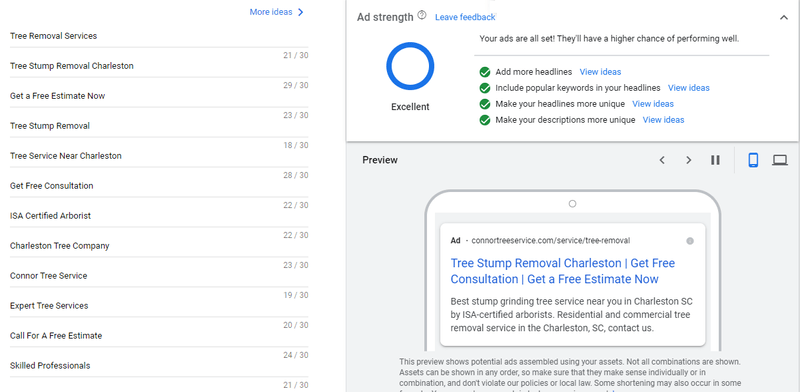
As you create your ad, you can see how it will display.
After a keyword search is done, the Google Ads within the search results display. At this moment, your ad is now competing with others in the effort to get the user to click on it.
This probably seems like a very important moment in time- and it is.
In this step, we will discuss the psychology of Google ad copy and important techniques to give your ad the best chance to convert during this pivotal time.
Analyze Competitor Ads
Don’t try and reinvent the wheel. All wheels, no matter what type- are round and feature a rim and a hub. Successful ads, at the most fundamental level, can be viewed in the same manner.
Look at the competition and literally pick apart their ads for good suggestions.
And on the other hand, if you notice some bad things, make note of “what not to do” when it comes time to write your ads.
By doing this, you save a lot of time and research.
In addition, there is software you can use to expedite this process:
Write compelling ads that are an “continuation” of the initial search.
Your target audience just conducted a search query looking for something. Now, try and put yourself in their mindset when you write the copy. Think of striking a balance with the proper amounts of info, emotion and assistance.
Your ad should also have a certain comfort level and normality about it.
All of these elements used in the proper amount will help make you a true Marketing Genius. We are being lighthearted about the last statement, but you get the point.
Tip: After writing your ads, imagine yourself on the other side and see if your ads “speak to you.” If they don’t- adjust them until they do.
Use great CTA text within the ads description and this will help the potential audience to perform the action.
Google has defined character limits- stay within them
Your ad headlines and descriptions absolutely must fall within Google predetermined character limits, or your ads will not be approved.
Have you ever read a cleverly written vehicle license plate? Of course you have and it takes a lot of thought to pull this off in around 7-8 characters. Lucky for us, Google allows a bit more range when writing ads.
Length limits
| Field | Max length |
| Headline 1 | 30 characters |
| Headline 2 | 30 characters |
| Headline 3 | 30 characters |
| Description 1 | 90 characters |
| Description 2 | 90 characters |
| Path (2) | 15 characters each |
Ad Testing Tools:
BlueWinston
NordicClick
Google Search Ads Guidelines- Think of this as the law.
There are reasons that laws were created- we all know that.
And there are prohibited many topics you cannot advertise for, such as areas relating to hate groups, sexual content, snake oil remedies and so on.
In addition, there are many practices you cannot do- such as misrepresenting your company… using malware… targeting minors, etc…
As you can imagine, there is a wide boundary of off limit stuff along with other areas featuring clear limitations.
It is always good to visit the Google Ads Policy Center to see if your ads fall within Google’s advertising ecosystem’s standards.
Think of ad copy like seeing a billboard while riding down the road. You have seven seconds or less to really impress.

If you have never written marketing style copy before, you should take at least a few hours to comb through several online resources which explain the concept.
Words, in this case, are EXTREMELY IMPORTANT. You don’t want to sound too bland- or too excited. Furthermore, you want your ad copy to be as compelling as possible in order to achieve basically two things:
- Be as relevant as possible to your potential customer.
- Have the highest chance of being clicked on.
Bad ad copy can either be a weak link in your PPC campaign- or be the strong “hook” that delivers a steady stream of good customers.
Step 4: Campaign Creation & Launch
Think of this step as the foundation of your campaign. Great homes are built on strong foundations and so are Google Ads.
Campaign Types
A campaign contains one or more ad groups, which share a campaign budget. Campaign types include Search, Display, Video, Shopping, Discovery, App, Local & Smart.
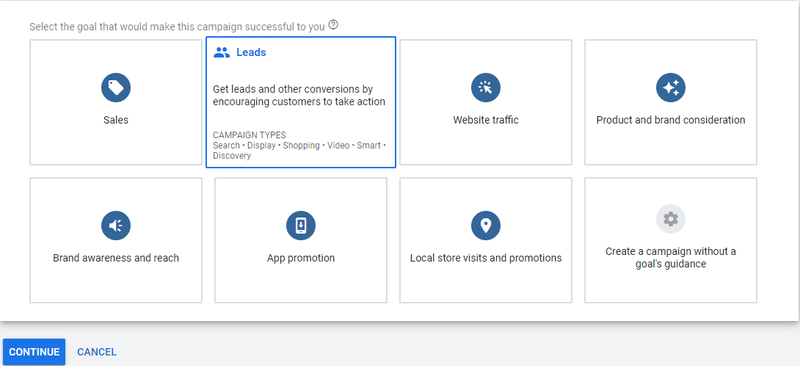
There are eight types of campaigns; most select either “Sales” or “Leads.”
The majority of the campaigns we have managed to date have been Search Campaigns which feature text ads.
However, this does not necessarily mean the near future and/or distant future will be the same as the Internet is always morphing… think of the shift to video over the last several years as bandwidth delivery has increased exponentially.
Create a campaign
After determining what type of campaign to create, now it’s time to set it up. For brevity’s sake, we are going to let Google better explain how to do it.
How to Create a Campaign.
Ad groups
An ad group contains one or more closely related ads and the associated keywords. You want to create an ad group when a group of keywords, for one example, are closely related and we must know the secret of Google ad groups.
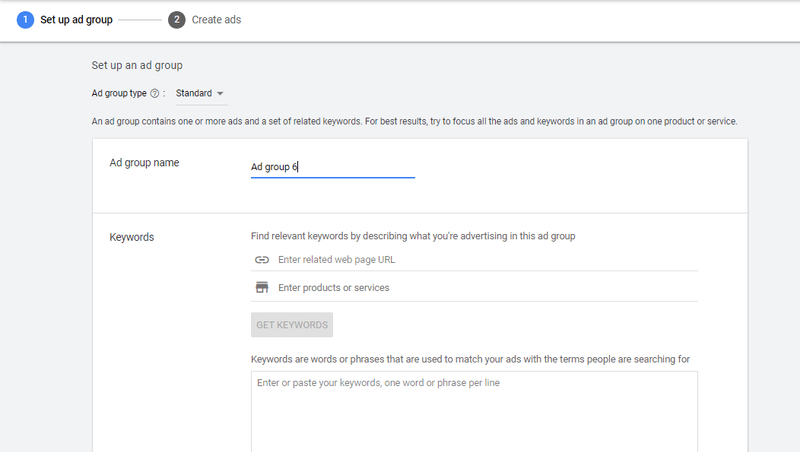
Choose your Ad Group name for a more clear delineation of your overall strategy.
This relationship between keywords and ad groups can greatly increase your conversion rate as the “buying experience” is more consistent with the user’s intent.
Think of Ad Groups as a system: Someone searches for a keyword, and a highly relative ad should display. Make the system work for you!

Don’t fall into the trap of creating one ad to serve a lot of keywords. Instead, create and add new ad groups (multiple groups for keywords) that serve small clusters of keywords- in some cases, just one keyword. Having 20-30 keywords per ad, for example, greatly lowers your CTR (click through rate) and overall campaign conversion.
When someone searches for a keyword, the ad that displays should be extremely relative to the keyword. Understanding this principle alone will greatly help you optimize your Google Ads campaign.
Step 5: Phone Call Tracking
Phone call tracking is an important (yet optional) component of your campaign. We mentioned optional but it is highly recommended to have it nd everyone must know the essential role of phone call tracking.
As you can imagine, leads mainly arrive in one of two ways- either by email or phone call.
In an ideal Google Ads campaign, a dedicated phone number is used and all messages are recorded, archived and reported to the customer.
Since many small businesses use cell phones as well as one primary office number, not having the ability to truly track phone call leads can cause your campaign to suffer in terms of overall ROI.
Enter phone tracking software.
At PalmettoSoft, we tend to use CallRail as our preferred tool, but there are many you can research and choose from. A normal cost should be starting around $50/month. If you think this cost is a bit high, think of the cost of losing a lead for your business.
Benefit to your customer
They are able to login at any time and see all calls sorted by date, time… and the calls are recorded for quality control, sales tracking, etc…
Benefit to you the vendor
You can see the same information as the customer and this information should feed directly into your biweekly or monthly performance report.
Phone tracking software offers many of the same benefits of having a robust phone system installed for your company- at a fraction of the cost a major phone company would charge.

Beware of assigning your Google Ads number to an employee’s cell phone or office number.
Since they are not the owner of the business, they can view this new task as a burden rather than an opportunity to help grow the business.
Furthermore, does an employee want their phone ringing seven days a week at all hours of the day? Nope.
Ultimately, this system will fail if the assigned person does not have “skin in the game.”
In the event the owner or executive manager recommends doing this, politely suggest using phone call tracking and tout the benefits of it.
Also… it will work very well.
Step 6: Campaign Monitoring
Congratulations! You have made it this far in our step by step Google Ads Strategy article
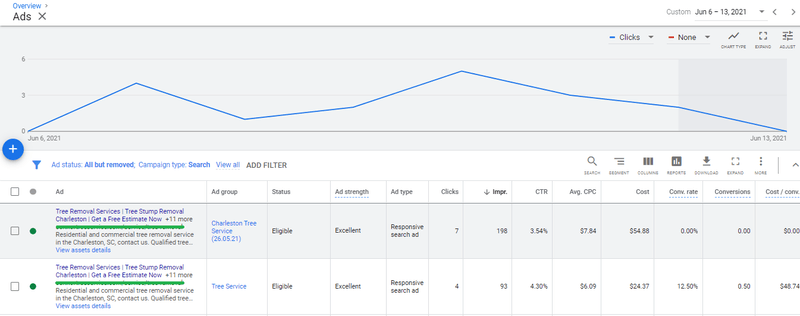
Here you can see ad performance as they are compared to each other.
Now that the Campaign Setup is complete, Routine work begins.
For the most part, the PalmettoSoft process is linear in nature, however, campaign monitoring should be on a continual basis. Think of driving your car and watching your fuel gage, or checking your tire pressure, ensuring your lights are in working order, etc… You always do these things, and for good reason.
Keyword bidding always changes with competitors jockeying for top positions, Google policies periodically change, there are holidays to consider, website email forms can break, and basically a whole bunch of other stuff is always happening.
So… be the watchful shephard!
For this post (and step), the main takeaway should be to routinely check your account- and this is not a one time event. As a rule of thumb, the larger the account, more and frequent monitoring should occur.
Campaign monitoring is Not a linear and/or one time event. Think of yourself as the shepherd looking over your flock. The wolves are always out there. However, in Google Ads they are not so clearly defined. You want to always look around the campaign with your eyes wide open- don’t get tunnel vision!

During campaign monitoring, you should always note important campaign tweaks, adjustments, notes of interest, etc., within the next scheduled reporting template. Your next scheduled report should be in a live document format.
Within the template, for example, you can feature a “Campaign Notes of Interest” section. And anything noteworthy that occurred prior to the report should always be featured in the following report.
Example of something noteworthy: In the middle of the month, you changed the ad schedule to no longer run on weekends.
Note that in the next report!!! Hint: You also may want to set up a future calendar event and see how your adjustment is doing… and note that too. Wash, rinse and repeat.
As developers, many tend to get in the robotic mindset of only populating data (i.e. Click Through Rate) in predetermined sections- and this practice is basically useless for about +95% of your customers.
Don’t think “Well, the client and I talked about it over the phone and by email, so I know they know about it.” No, they don’t remember everything; they pay you to do that. Developers who think like that will always be… just developers- and not highly successful in business.
Most customers tend to remember only a fraction of what we do about their account. It’s because they are busy running their own business…. So document important information in the appropriate important document.
Step 7: Add New Keywords

Selecting “Match Type” is a fluid, yet very important action to make.
After one week of the campaign being live (and moving forward), we use Google’s auction insights data that compares the keyword performance with other advertisers competing with you in the same market.
Based on the findings, we add and/or modify keywords.
Basically, auction insights can provide a good, high level understanding when it comes to bidding and budgeting.
Once you determine which keywords you want to zero in on, then it’s time to maximize that effort.
Keyword Match Type: The three major ways in which to optimize your keywords
Broad Match
This is the default setting which provides the most keywords opportunities. Think of Broad Match as the most “hands off and loose way” to manage your keywords. You can also think “I just opened the floodgates.” Because in many cases- you did.
Learn more about Broad Match.
Phrase Match
With this setting, you are beginning to tighten down control of keyword management. This setting allows keywords to be matched to phrases along with user intent- the algorithm is doing more work in this one!
Learn more about Phrase Match.
Exact Match
“I only want to find users who type in this exact phrase.” No less and no more. When you are selling a very unique product or service, or have an extremely competitive keyword, drilling down to specifics can be very important.
Learn more about Exact Match.
Special Note: Negative Keywords are explained in the next step- don’t worry, we didn’t forget!
Over time, you will notice particular quality keywords that are delivering a lot of traffic- and you want to begin to tweak the entire campaign a bit towards those. Think of your ad groups, ad copy, landing page copy, etc… Capitalize on what the public is looking for!

When using match types to optimize keywords, you can literally open the flood gates to unwanted traffic- or constrict the life out of your campaign.
You should continually read up on this topic and reassess your keyword settings. In time, you want to achieve the most optimal flow of inbound traffic best matched to what you are selling.
Step 8: Negative Keywords Filter

Add or “filter out” any keywords that are not relevant to your business.
The Negative Keywords Filter’s importance in your campaign cannot be understated. It is extremely important.
Negative keywords allow you to selectively “filter out” any particular search terms that you don’t want to display your ads.
For instance, if you only sell services to commercial customers, you definitely want to exclude keywords such as “home, house, residential, etc…”

With this particular client, they provide only commercial and industrial services. As a result, we filtered out all mentions of residential-type keywords.
The above terms would be added in the negative keywords filter. Any time someone searches for one of these terms, your ad will not display.
Learn more about Negative Keywords Filter.
Using negative keywords filtering can be a great method in which to save your campaign budget from invalid clicks- and also any unwanted business that may come with it.

You need to understand the intricacies of exactly how negative keywords can function. Otherwise, you could literally strangle your PPC campaign from the customers you are trying to attract to your website
Think of the filter as the security guard at the entrance of a bar… they need to be trained very well in understanding “who” to let in, as well as “who” not to let in. This will take time as well as constant monitoring. However, in the long run, having a “good guard” will be a great asset for your campaign.
Step 9: Bidding Adjustment
Know This: Having your ads appear at the top of the search results vs. competitor ads will get more clicks.
As you know, withIn the English language, we read from top to bottom- so when your ad is one of the first seen, the likelihood of it being clicked on is much higher than if it is at the bottom of the search results page.
Within Google Ads, ad positioning is based upon competitors who bid against each other. Those who bid higher on a keyword will be placed above one that doesn’t.
Takeaway: Over time, the cost of Google Ads will almost always increase. So… the bidding adjustment strategy is extremely important for short and long term campaign ROI.
Adjusting the cost of your keywords can mainly either be done two ways:

What is your ultimate goal for your campaign? For many, Conversions (website leads) is the most important selection.
PalmettoSoft prefers manual bidding because over time, automated bidding tends to continually increase the cost of your campaign and offer lower ROI.
Notice we said “tends.” Basically, automated bidding uses an algorithm to oversee your campaign rather than a person. As with anything, there is good and bad with this process.
Because we are certified within the Google Ads system, we are able to operate much more efficiently, on average, than the algorithm. Basically, we know the in and outs and always make adjustments in our customer’s favor. The same cannot be said for automated bidding.
While the algorithm is smart and constantly improving, simply pressing “go” and letting machine learning oversee your campaign is not what we recommend- unless you have an unlimited marketing budget.
Imagine going on a month-long trip out of the country and setting the air conditioning temp of your house to 60F- and it’s summer. Guess what your next electrical is going to look like.
Automated bidding can work much like your thermostat.
Within the bidding process, there is a lot to learn and we recommend spending time on Google’s site to become as familiar with the system as possible. In time and with a lot of studying, basic knowledge can ultimately transform into what we call strategic management.
Without going too deep into technical detail, a thorough understanding of the bidding process can also result in a blending of both manual and automated bidding options.
Bidding adjustment should be looked at frequently because proper bidding can place your ad at the top of the search results; ultimately increasing the traffic to your website!

You want to constantly do bid adjustments to your keywords and keep them in the top positions. Why?
One reason is your competitors are continually doing it. Once a keyword bid falls to the bottom of the list against competition, you can almost guarantee it will never be clicked on.
Think about it: How many times have you clicked on a paid ad at the bottom of a web page? Probably almost never.
Step 10: Reporting
The end step of your Google Ads process is reporting and this is where both the optimizer and customer should understand how the campaign is performing in the same terms. Advanced reporting techniques should contain a few main features:
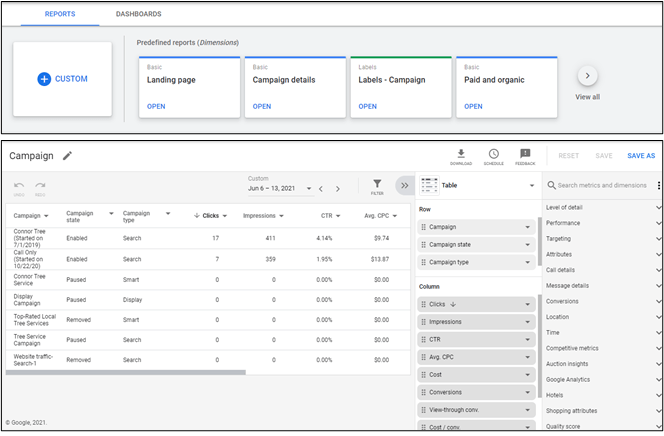
From here, a report can be downloaded- and customized to meet your needs.
Monthly/Weekly/Biweekly Google Ads Performance Report
At minimum, the report should feature a summary, technical information like (Clickthrough Rate, Cost, Customer Lead Conversions, Cost Per Conversion, Conversion Rate).
Elements of a Monthly Campaign Performance Report- What it should contain
Campaign Performance: What we are seeing
Talk about some high level points of interest in layman’s terms. Think of something noteworthy the client would really find interesting. Sprinkle in some math to back up what you are saying.
Campaign Adjustment(s): What we recently did
Talk about the good recent campaign tweaks you have done here.
Campaign Recommendation(s): What we need to do
This is self explanatory. As you have been working in the campaign, this is a section to recommend proactive things like increasing the reduce/increase the targeted radius, budget, landing page adjustment, etc…
Reporting is a very important time during the PPC campaign. Tell the client what time it is- and NOT how the clock is made. All parties will benefit from this mindset.

If you don’t mention campaign recommendations based on campaign performance then the campaign will not get success. Always adjust your campaign based on the previous period performance.
Summary
If you are a developer or casual reader, we hope you gained something of value from this Google Ads tutorial.
While there are many ways on how to set up Google Ads and implement a Google Ads strategy, this is the way we do it at PalmettoSoft, and we have been quite successful at it. When in doubt about a technique, you should always do your research to find the best white hat method.
Don’t forget that Google Ads optimization techniques periodically change (typically evolve). And your resulting Google Ads strategy should adjust with it . In time, like all marketing systems, things change. As you work in this area, you can tweak your strategy to adjust with the times.
And if you are still stumped, feel free to contact us (link to contact page) and we will do our best to steer you in the right direction. We would love to be your Google Ads guide!
Finally, the best performing Google Ads campaigns tend to be the ones where customers take a personal interest in the success of it . After all, their input and thoughts can help provide critical guidance to long-term success.
FAQs
Google Ads (formerly known as AdWords) is an online marketing solution and form of pay per-click-advertising where advertisers (websites) display their ads on the Google Ad network. This includes Google.com and YouTube.com, mainly.
Basically, advertisers set up a Google Ads account, set a budget, goals, and create an ad or series of ads targeted for specific keywords that are type into the search engine.
Google Ads also allows advertisers to bypass SEO (search engine optimization) and be placed in contact with the potential buyer- in a very short time. Basically, as long as it takes to set up the account and activate it. Viola! The ads display.
Also, you want to think of Google Ads much like a system, where a chain of events takes place. For example: A person searches a keyword on Google, then the advertiser’s ad displays; the person clicks on it- and lands on a special landing page designed to maximize customer conversion.
In addition, Google allows the advertiser to bid on the price of keywords (per click), set times of the day and week the ad appears and also the ability to run the campaign in different geographical zones. And a lot more real-time functionality.
It is also important to note that typically the price of a Google Ads campaign increases over time as more advertisers bid against each other- thereby driving up the cost per click for each keyword.
Takeaway: It can be a great short term online marketing solution.
Ans: There are three basic types of Google Ads below. They are also displayed with the most common on top in a descending order.
Search Network: These text ads appear at the top and bottom of the search results page when someone searches for a product or service. They also tend to be relevant to the initial search itself.
Display Network: These image ads appear on websites or apps your customers typically visit. They tend to follow the user’s search habits based on collected cache history. Also, member websites who elect to display the ad have also chosen the same search type category as the user.
For more technical clarity, “advertisers” create the ads and “publishers” show the ads on their websites. The publisher, of course, gets paid to display the image ad. Space is created for these ads within the website and they periodically rotate in and out.
Video: These short video ads appear right before or during YouTube content. Also, the more viewers/popular the video is- the more ads you will see (and they tend to be a bit longer).
Additional Campaign Types: To include but not limited to Shopping campaigns, App Campaigns and more…
Ans: Google Ads cost is based on the budget that you create. For example, a $1000/month budget could be segmented into a daily budget of $33.33/day (based on a 30 day calendar month). Furthermore, you are only charged when someone clicks on your ad.
Ans: Per keyword- the Quality Score (ranging from 1-10, with 10 being the best) is a ranking metric that measures the value of a keyword in relation to its ad copy and associated landing page.
Higher quality scores can result in a lower cost per click (CPC) as the user has a better “buying experience” as these elements of the campaign act as more of an “integrated system.”
Ans: Yes.
A higher Clickthrough Rate (CTR), is tracked by Google Ads and it will see your ad is receiving a higher number of clicks. This also translates that your ad is more relevant to the user’s search. Ultimately, this positively affects the Google Ads quality score.
Ans: Yes.
An impression is how many times your ad appears on a device (computer, tablet, smartphone, etc.).
A click is when someone actually clicks on your ad.
Clickthrough Rate (CTR) is determined by the ratio of the above two metrics. The higher the CTR… this essentially means the relevancy of your ad to the user’s search is more relevant- and this ratio should constantly be monitored for several beneficial reasons.
For example, for every 100 impressions, if someone clicks on your ad, the CTR score would be 2%. Aiming for a higher CTR would cause you to reanalyze your ad’s wording, and other things to make it more relevant… and “clickable.”
Ans: Automated bidding is a function offered by Google Ads which uses machine learning insights to adjust bidding for your keywords. Basically, Google Ads does the “heavy lifting” work to meet your previously set marketing goal (done by you within the Google Ads system).
This program is designed for beginners who don’t have the capability to run campaigns (based on their limited experience and analytical ability).
Automated bidding is also NOT advisable for lower budgets because typically, the campaign budget is increased by Google. As you can imagine, this system works great for generating more revenue for Google.
For higher budgets, automated bidding works better as there is more “wiggle room,” to make campaign adjustments- which ultimately tends to result in higher ROI.
In many cases, certified Google Ads Professionals, such as PalmettoSoft, do NOT use the automated bidding function. Why? Because our team is able to make higher yielding ROI adjustments than the algorithm.
Ans: Yes.
In order to track conversions, you must first sign into your Google Ads account and follow their step by step instructions found here. Ultimately, Google Ads will provide tracking code you must install on your website.
If you are not able to do this work, have a professional such as PalmettoSoft do this for you.
Ans: Ad Groups: You can create up to but not more than 10,000 ad groups.
Ad Campaigns: You can create up to but not more than 20,000 ad campaigns.
These numbers are incredibly high… just in case you were wondering. We think these parameters are more for e-Commerce websites, which tend to require more granularity and finite tracking.
Ans: Yes, ad extensions provide important information with USP (unique selling point) text at the end of your ad. For example, “15 years experience,” “Insured/Bonded,” even click to call features such as your phone number can be used.
Ad extensions can ultimately help facilitate more clicks on your ad by enticing the viewer either by marketing language or call to action features.
With proper usage of ad extensions you can get more clicks without having to raise your cost per click.
Learn more about extensions to use.
Ans: No. You don’t have to be certified in Google Ads to run a campaign. However, if you are not certified, you need to be very careful as you do the setup work as well as launch.
Basically, it boils down to a cost vs. benefit analysis.
Is your job… or goal… highly dependent on the success of a Google Ads campaign? If “yes,” then we recommend getting certified as the return on investment (ROI) probably be exponentially higher as opposed to going into it blind.
If you are too busy running your business and don’t have the time or justification to do so- then we recommend having a Google Ads Certified agency like PalmettoSoft do this work for you. Ultimately, you will get the ROI you want.
